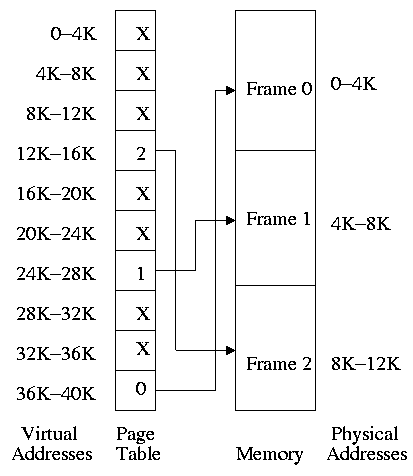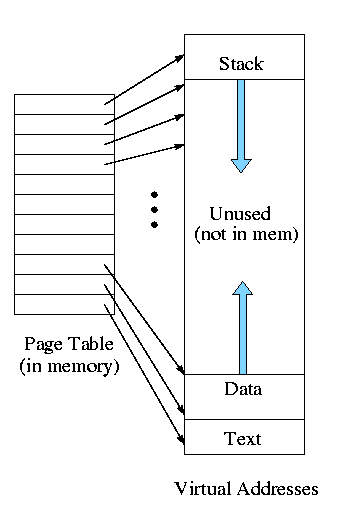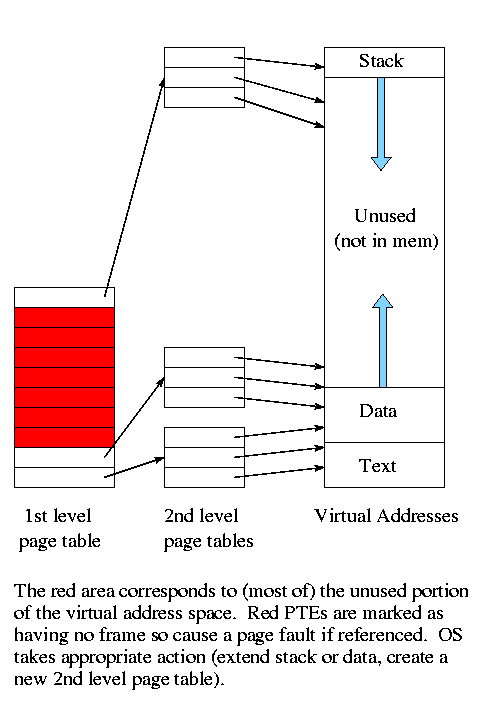================ Start Lecture #10
================
NOTE:
Homeworks are accepted by email (sent to me), but they MUST be SENT
BEFORE (repeat BEFORE) class begins.
END OF NOTE:
4.3: Virtual Memory (meaning fetch on demand)
Idea is that a program can execute even if only the active portion of its
address space is memory resident. That is, swap in and swap out
portions of a program. In a crude sense this can be called
``automatic overlays''.
Advantages
- Can run a program larger than the total physical memory.
- Can increase the multiprogramming level since the total size of
the active, i.e. loaded, programs (running + ready + blocked) can
exceed the size of the physical memory.
- Since some portions of a program are rarely if ever used, it is
an inefficient use of memory to have them loaded all the time. Fetch on
demand will not load them if not used and will unload them during
replacement if they are not used for a long time (hopefully).

4.3.1: Paging (meaning demand paging)
Fetch pages from disk to memory when they are referenced, with a hope
of getting the most actively used pages in memory.
- Very common: dominates modern operating systems.
- Started by the Atlas system at Manchester University in the 60s
(Fortheringham).
- Each PTE continues to have the frame number if the page is
loaded.
- But what if the page is not loaded (exists only on disk)?
- The PTE has a flag indicating if it is loaded (can think of
the X in the diagram on the right as indicating that this flag is
not set).
- If not loaded, the location on disk could be kept in the PTE
(not shown in the diagram). But normally it is not
(discussed below).
- When a reference is made to a non-loaded page (sometimes
called a non-existent page, but that is a bad name), the system
has a lot of work to do. We give more details
below.
- Choose a free frame, if one exists.
- If not
- Choose a victim frame.
- More later on how to choose a victim.
- Called the replacement question
- Write victim back to disk if dirty,
- Update the victim PTE to show that it is not loaded
and, perhaps, where on disk it has been put.
- Copy the referenced page from disk to the free frame.
- Update the PTE of the referenced page to show that it is
loaded and give the frame number.
- Do the standard paging address translation (p#,off)-->(f#,off).
- Really not done quite this way
- There is ``always'' a free frame because ...
- There is a deamon active that checks the number of free frames
and if this is too low, chooses victims and ``pages them out''
(writing them back to disk if dirty).
- Choice of page size is discussed below.
Homework: 12.
4.3.2: Page tables
A discussion of page tables is also appropriate for (non-demand)
paging, but the issues are more acute with demand paging since the
tables can be much larger. Why?
- The total size of the active processes is no longer limited to
the size of physical memory. Since the total size of the processes is
greater, the total size of the page tables is greater and hence
concerns over the size of the page table are more acute.
- With demand paging an important question is the choice of a victim
page to page out. Data in the page table
can be useful in this choice.
We must be able access to the page table very quickly since it is
needed for every memory access.
Unfortunate laws of hardware.
- Big and fast are essentially incompatible.
- Big and fast and low cost is hopeless.
So we can't just say, put the page table in fast processor registers,
and let it be huge, and sell the system for $1500.

For now, put the (one-level) page table in main memory.
- Seems too slow since all memory references require two reference.
- TLB very helpful to reduce the average delay as mentioned above
(discussed later in more detail).
- The page might be too big.
- Currently we are considering contiguous virtual
addresses ranges (i.e. the virtual addresses have no holes).
- Typically put the stack at one end of virtual address and the
global (or static) data at the other end and let them grow towards
each other.
- The memory in between is unused.
- This unused memory can be huge (in address range) and hence
the page table will mostly contain unneeded PTEs.
- Works fine if the maximum virtual address size is small, which
was once true (e.g., the PDP-11 of the 1970s) but is no longer the
case.
Contents of a PTE
Each page has a corresponding page table entry (PTE). The
information in a PTE is for use by the hardware. Information set by
and used by the OS is normally kept in other OS tables. The page
table format is determined by the hardware so access routines are not
portable. The following fields are often present.
- The valid bit. This tells if
the page is currently loaded (i.e., is in a frame). If set, the frame
pointer is valid. It is also called the presence or
presence/absence bit. If a page is accessed with the valid
bit zero, a page fault is generated by the hardware.
- The frame number. This is the main reason for the table. It is
needed for virtual to physical address translation.
- The Modified bit. Indicates that some part of the page
has been written since it was loaded. This is needed when the page is
evicted so the OS can know that the page must be written back to disk.
- The referenced bit. Indicates that some word in the page
has been referenced. Used to select a victim: unreferenced pages make
good victims by the locality property (discussed below).
- Protection bits. For example one can mark text pages as
execute only. This requires that boundaries between regions with
different protection are on page boundaries. Normally many
consecutive (in logical address) pages have the same protection so
many page protection bits are redundant.
Protection is more
naturally done with segmentation.
Multilevel page tables (Sadly skipped in 2001-2002 Fall)
Recall the previous diagram. Most of the virtual memory is the
unused space between the data and stack regions. However, with demand
paging this space does not waste real memory. But the single
large page table does waste real memory.

The idea of multi-level page tables (a similar idea is used in Unix
inode-based file systems) is to add a level of indirection and have a
page table containing pointers to page tables.
- Imagine one big page table.
- Call it the second level page table and
cut it into pieces each the size of a page.
Note that you can get many PTEs in one page so you will have far
fewer of these pages than PTEs
- Now construct a first level page table containing PTEs that point to
these pages.
- This first level PT is small enough to store in memory.
- But since we still have the 2nd level PT, we have made the world
bigger not smaller!
- Don't store in memory those 2nd level page tables all of whose PTEs
refer to unused memory. That is use demand paging on the (second
level) page table
Do an example on the board
The VAX used a 2-level page table structure, but with some wrinkles
(see Tanenbaum for details).
Naturally, there is no need to stop at 2 levels. In fact the SPARC
has 3 levels and the Motorola 68030 has 4 (and the number of bits of
Virtual Address used for P#1, P#2, P#3, and P#4 can be varied).
4.3.3: TLBs--Translation Lookaside Buffers (and General
Associative Memory)
Note:
Tanenbaum suggests that ``associative memory'' and ``translation
lookaside buffer'' are synonyms. This is wrong. Associative memory
is a general structure and translation lookaside buffer is a special
case.
An
associative memory is a content addressable
memory. That is you access the memory by giving the value
of some field and the hardware searches all the records and returns
the record whose field contains the requested value.
For example
Name | Animal | Mood | Color
======+========+==========+======
Moris | Cat | Finicky | Grey
Fido | Dog | Friendly | Black
Izzy | Iguana | Quiet | Brown
Bud | Frog | Smashed | Green
If the index field is Animal and Iguana is given, the associative
memory returns
Izzy | Iguana | Quiet | Brown
A Translation Lookaside Buffer
or TLB
is an associate memory
where the index field is the page number. The other fields include
the frame number, dirty bit, valid bit, and others.
-
A TLB is small and expensive but at least it is
fast. When the page number is in the TLB, the frame number
is returned very quickly.
-
On a miss, the page number is looked up in the page table. The record
found is placed in the TLB and a victim is discarded. There is no
placement question since all entries are accessed at the same time.
But there is a replacement question.
Homework: 17.
4.3.4: Inverted page tables
Keep a table indexed by frame number with the entry f containing the
number of the page currently loaded in frame f.
- Since modern machine have a smaller physical address space than
virtual address space, the table is smaller
- But on a TLB miss, must search the inverted page table.
- Would be hopelessly slow except that some tricks are employed.
- The book mentions some but not all of the tricks, we are skipping
this topic.
4.4: Page Replacement Algorithms (PRAs)
These are solutions to the replacement question.
Good solutions take advantage of locality.
- Temporal locality: If a word is referenced now,
it is likely to be referenced in the near future.
- This argues for caching referenced words,
i.e. keeping the referenced word near the processor for a while.
- Spatial locality: If a word is referenced now,
nearby words are likely to be referenced in the near future.
- This argues for prefetching words around the currently
referenced word.
- These are lumped together into locality: If any
word in a page is referenced, each word in the page is ``likely'' to
be referenced.
- So it is good to bring in the entire page on a miss and to
keep the page in memory for a while.
- When programs begin there is no history so nothing to base
locality on. At this point the paging system is said to be undergoing
a ``cold start''.
- Programs exhibit ``phase changes'', when the set of pages referenced
changes abruptly (similar to a cold start). At the point of a phase
change, many page faults occur because locality is poor.
Pages belonging to processes that have terminated are of course
perfect choices for victims.
Pages belonging to processes that have been blocked for a long time
are good choices as well.
Random PRA
A lower bound on performance. Any decent scheme should do better.
4.4.1: The optimal page replacement algorithm (opt PRA) (aka
Belady's min PRA)
Replace the page whose next
reference will be furthest in the future.
- Also called Belady's min algorithm.
- Provably optimal. That is, generates the fewest number of page
faults.
- Unimplementable: Requires predicting the future.
- Good upper bound on performance.
4.4.2: The not recently used (NRU) PRA
Divide the frames into four classes and make a random selection from
the lowest nonempty class.
- Not referenced, not modified
- Not referenced, modified
- Referenced, not modified
- Referenced, modified
Assumes that in each PTE there are two extra flags R (sometimes called
U, for used) and M (often called D, for dirty).
Also assumes that a page in a lower priority class is cheaper to evict.
- If not referenced, probably not referenced again soon so not so
important.
- If not modified, do not have to write it out so the cost of the
eviction is lower.
-
When a page is brought in, OS resets R and M (i.e. R=M=0)
-
On a read, hardware sets R.
-
On a write, hardware sets R and M.
We again have the prisoner problem, we do a good job of making little
ones out of big ones, but not the reverse. Need more resets.
Every k clock ticks, reset all R bits
- Why not reset M?
Answer: Must have M accurate to know if victim needs to be written back
- Could have two M bits one accurate and one reset, but I don't know
of any system (or proposal) that does so.
What if the hardware doesn't set these bits?
-
OS can use tricks
-
When the bits are reset, make the PTE indicate the page is not
resident (i.e. lie). On the page fault, set the appropriate bit(s).
4.4.3: FIFO PRA
Simple but poor since usage of the page is ignored.
Belady's Anomaly: Can have more frames yet generate
more faults.
Example given later.
4.4.4: Second chance PRA
Similar to the FIFO PRA but when time choosing a victim, if the page
at the head of the queue has been referenced (R bit set), don't evict
it.
Instead reset R and move the page to the rear of the queue (so it
looks new).
The page is being a second chance.
What if all frames have been referenced?
Becomes the same as fifo (but takes longer).
Might want to turn off the R bit more often (say every k clock ticks).
4.4.5: Clock PRA
Same algorithm as 2nd chance, but a better (and I would say obvious)
implementation: Use a circular list.
Do an example.
LIFO PRA
This is terrible! Why?
Ans: All but the last frame are frozen once loaded so you can replace
only one frame. This is especially bad after a phase shift in the
program when it is using all new pages.
4.4.6:Least Recently Used (LRU) PRA
When a page fault occurs, choose as victim that page that has been
unused for the longest time, i.e. that has been least recently used.
LRU is definitely
- Implementable: The past is knowable.
- Good: Simulation studies have shown this.
- Difficult. Essentially need to either:
- Keep a time stamp in each PTE, updated on each reference
and scan all the PTEs when choosing a victim to find the PTE
with the oldest timestamp.
- Keep the PTEs in a linked list in usage order, which means
on each reference moving the PTE to the end of the list
Homework: 29, 23
A hardware cutsie in Tanenbaum
- For n pages, keep an nxn bit matrix.
- On a reference to page i, set row i to all 1s and col i to all 0s
-
At any time the 1 bits in the rows are ordered by inclusion. I.e. one
row's 1s are a subset of another row's 1s, which is a subset of a
third. (Tanenbaum forgets to mention this.)
-
So the row with the fewest 1s is a subset of all the others and is
hence least recently used
- Cute, but still impractical.



